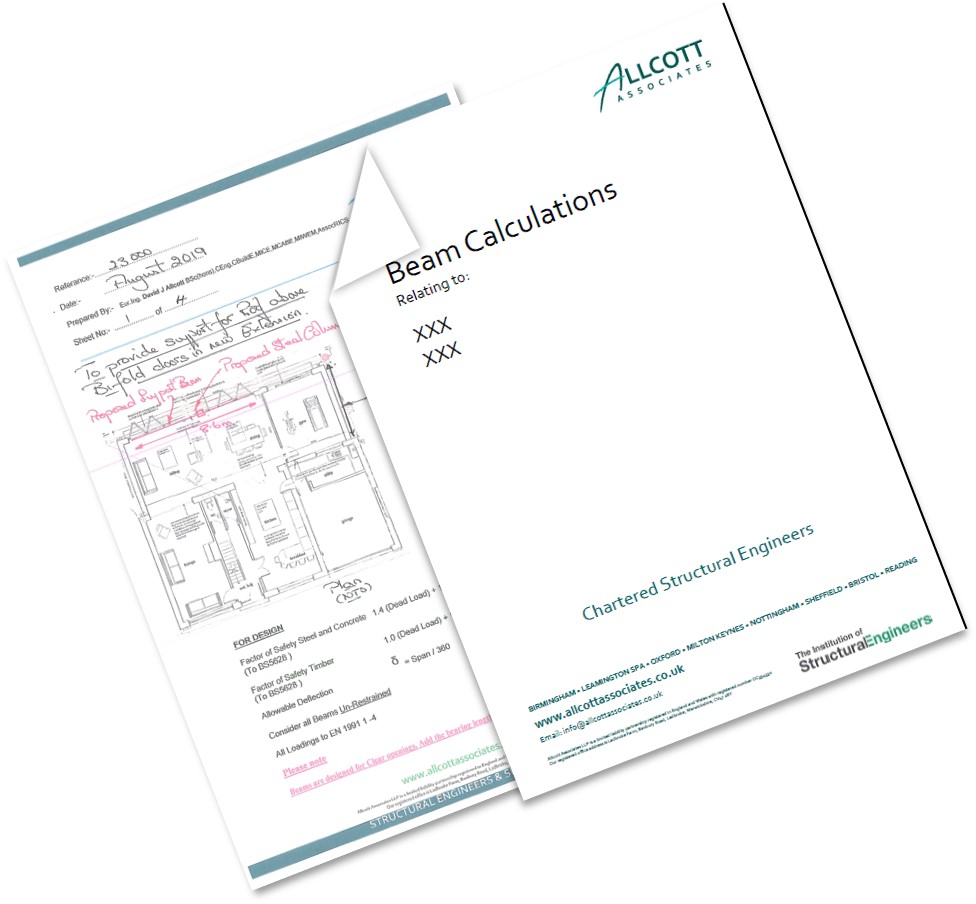Structural Engineer Calculations for Wall Removals: Oxfordshire
Regulated by RICS
Instant Quote | NO OBLIGATION
Or Call 0333 200 7198
Our Oxfordshire Structural Engineers are often asked to provide beam designs and calculations for wall removal projects – these reports are then used to obtain building regulations approval for the works.
Structural Calculations for Wall Removal
Load bearing vs non-load bearing
Most enquiries come from people who are removing a load-bearing wall and need a steel beam (also known as an RSJ) to replace the wall.
Most commonly these are on the ground-floor, and often either opening up between a kitchen and dining room, or between and existing structure and a new extension or conservatory.
We are also sometimes asked to visit to assess if a wall is load-bearing or not.

Site visit
Our engineers will always visit site. This allows them to check whether the wall is load-bearing, and to ensure that that the most suitable beam is designed the first time. They will check the loadings involved and review the structure of the surrounding building to check its suitability.
The site visit involves the engineer completing the following tasks.
- Checking the loadings involved and reviewing the structure of the surrounding building to check the suitability of the proposed works.
- Assessing the thickness and construction type of the walls, so that this can be taken into account when designing the beam.
- Assessing whether or not the existing masonry can be used to support the end of the beam, or alternatively, if the masonry would be at risk of damage or failure, padstones are required.
- Assessing all the elements that the beam will support, such as floor joists, walls on the floor above and timber partitions.
- Checking whether the walls above load the relevant walls.
Calculations required for removing a load-bearing wall
Dead loads are forces acting on the wall or beam imposed by the weight of the structure itself. These include structural elements such as walls, roofs, floor joists, timbers, ceilings and insulation. These are usually fairly constant over time.
Imposed loads are forces arising from weights that are temporary or changeable. In a residential house, this would normally comprise furniture and people. Engineers use standard imposed loads according to the type of room above a wall.
Our engineers calculate dead loads and imposed loads in accordance with BS EN 1991 Part 1-4.
Beam designs are undertaken in accordance with BS5950 Part 1, and bearing designs in accordance with BS5628 Part 1. Designs include detailed information and diagrams illustrating the beam design and minimum requirements. Support conditions, applied loading and load combinations are detailed, and shear resistance, moment capacity, compressive strength and bending strength and deflection are tested.

Special Considerations: a case study
Our site visit allows us to understand other structures that could be affected by the installation of the beam.
- In this example, where a client wanted to knock through from their kitchen to their dining room, french doors from the dining room to the garden had a concrete lintel that would clash with the bearing for the new beam (i.e. the part that needs to rest on a supporting structure).
- We provided three options:
- Install the beam as a downstand to the underside of the floor joists, retaining a nib to the end of an internal wall. However, this may impact on the proposed kitchen fit out.
- Install the beam as a downstand to the underside of the floor joists, cutting back the existing lintel, tooth in new cavity wall invist to existing brick and blockwork to ensure load spread through the wall and providing a padstone. The end of the lintel would need to be exposed first to confirm this option was practical.
- Installing the beam within the depth of the floor joists, providing proprietary joist hangers to support the existing timber joists off the new steel beam. The end of the beam could then be beared onto the top of the existing lintel. Again, the end of the lintel would need to be exposed first to confirm this option was practical.
- We provided three options:
Looking for commercial structural engineering services?
Our commercial structural engineers offer a wide range of structural engineering services for all commercial property types, from large portal frames and office blocks to period retail properties.
Visit our commercial site
to find out more about commercial beam calculations and our other commercial engineering specialisms.
Reviewing past wall removals
Clients sometimes ask us to check areas where walls have been removed in the past, but building regualtions documentation is unavailable.
This involves a visual inspection of the area where the wall was. Our engineers will be:
- looking for any damage or distortion
- assessing where the direction of the floor joists on the level above to indicate if there was any load on the area where the wall was removed
- assessing walls on the level above and how the roof structure is being supported.
If there is no load from the floor joists, and the above wall is not a supporting structure, there would be no load on the lower level.
Metal detectors can be used to assess the presence of steel beams where a wall was load-bearing; for example, if it was part of the original supporting structure, or was supporting floor joists above. Although this cannot tell us the size of the beams, we can look for signs of distortion, deflection or cracking to assess whether the steel beam is adequate for purpose.
Sometimes an intrusive investigation will be recommended to confirm the direction of the floor joists and whether or not a concealed support is present.
Allcott Associates beam design and calculations
A beam calculation report typically includes calculations sheets, dead loads, imposed loads and detailed design notes. The report will include information on the British and European safety standards that the calculations adhere to.
If required, the report will also include detailed fabrication drawings, and tailored notes for you, your builder and your architect.
For an instant Beam Calculation quote please click here.
For more information or a tailored quote, email us at info@allcottassociates.co.uk, or give us a call on 0333 200 7198.
To find out more about our commercial beam calculations, please visit Allcott Commercial.
Or contact us for more information:
info@allcottassociates.co.uk | 0333 200 7198












